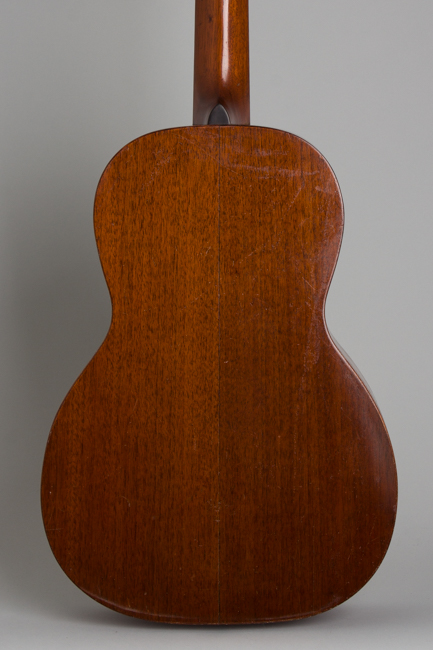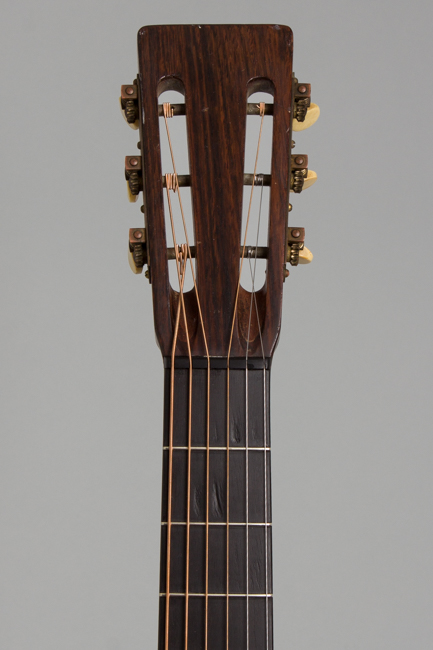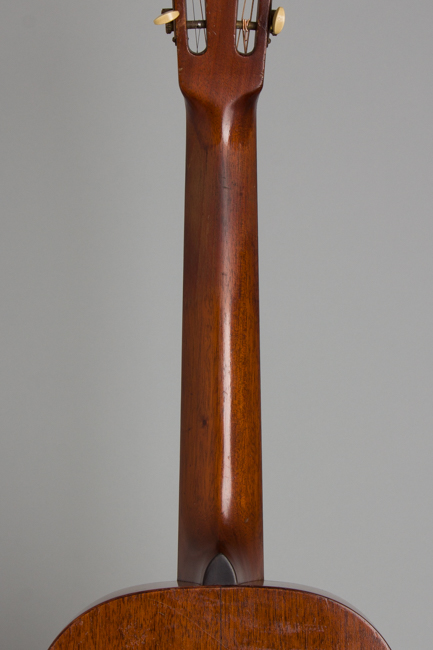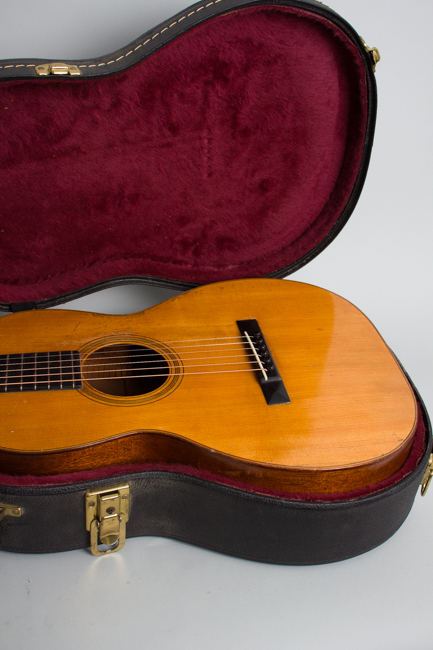C. F. Martin 0-18 Flat Top Acoustic Guitar (1926)
This item has been sold.
Item # 10451
Prices subject to change without notice.
C. F. Martin 0-18 Model Flat Top Acoustic Guitar (1926), made in Nazareth, PA, serial # 26188, natural lacquer finish, Adirondack spruce top, Honduras mahogany sides and neck, ebony fingerboard and bridge, black hard shell case.
This is a well-played but great sounding 0-18 from mid/late 1926, the golden era of these original 12-fret "old style" standard Martins. By that year the 0-18 had only just settled into its specifications as a steel-string guitar, which was still a fairly new idea at Martin. This model has slightly beefed-up construction compared to its 1910s gut-strung ancestors, but by modern standards the scalloped X pattern remains extremely light and delicate.
The Style 18 had begun to be offered with steel strings only in 1923; this model was Martin's first spruce top guitar so equipped from the factory and soon became a very popular instrument. Legions of Hawaiian players, vaudeville players and string band musicians were looking for guitars just like this in the mid-20s, and Martin had hit on a formula that scored big. As a result 1926 was the peak production year for the "old style" 0-18 with 900 shipped, second only to the budget all-mahogany 2-17 in sales volume. The price was raised from $35 to $40 in the middle of the year likely indicating the factory was having trouble keeping up with demand!
The 0-18 is a 13 1/2" wide mahogany-bodied guitar with relatively plain trim. It would only be continue to be built in this 12-fret form up through the end of this decade before the advent of pickguards and 14-fret neck joints changed its character in the 1930s. This 1926 guitar has its tight-grained Adirondack spruce top braced to handle steel string tension but is identical cosmetically to its gut strung ancestors. The other features remain as before; the top and back are bound with rosewood and the narrow flat-ended bridge and 1 13/16" wide fingerboard made of very high-grade dark ebony. The position marks are three simple descending-sized pearl dots, the nut is ebony, and the tuners on the slotted headstock are unplated Waverly strips with grained ivoroid buttons.
This small-bodied mahogany guitar may have been near the bottom of the Martin line, but this was still a more expensive instrument than many competing 1920s flat-tops. It is built throughout to the lofty standards that only C.F. Martin & Co. ever sustained, most discerning players at the time would have considered this 0-18's combination of features and price to be the best of its type in the world.
This is a well-used but fine playing instrument, considered a classic old-time string band or solo guitar but really suitable for just about any style of play. The sound is more powerful than one might expect from an instrument this size, full-bodied with surprising depth. It makes a great fingerstyle guitar but also works quite well with a flatpick. This is simply a wonderful 12-fret guitar, and in this used but largely unaltered condition something we just don't see that much anymore.
Overall length is 38 in. (96.5 cm.), 13 1/2 in. (34.3 cm.) wide at lower bout, and 4 1/8 in. (10.5 cm.) in depth at side, taken at the end block. Scale length is 24 3/4 in. (629 mm.). Width of nut is 1 13/16 in. (46 mm.).
This is a played-in but still nicely original 98 year old Martin, showing general wear overall but no abuse or major damage/repair. The finish remains mostly original everywhere except the back of the neck, which shows a light buffed overspray where the original thin finish wore through to the wood. The very thin lacquer shows dings, dents, and scrapes overall with some noticeable pickwear in the area below the soundhole and off the lower waist. The area nearer the bridge has some light overfinish on the strummed-through zone; that was not done to the area below the soundhole. The lower sides have some heavy checking and moisture wear. There is one noticeable small gouge in the wood behind the bridge.
There are several short repaired side cracks along the turn of the lower bass bout, with a pair of spruce grain cracks on the top in the same area; it looks like the guitar took a small hit there decades ago. Along the lower curve below the endpin there is one more neatly sealed grain split. The lower waist has a similar grain split sealed and cleated. Apart from the one impact incident the top is free of cracks, notably in the crucial area below the bridge.
The small ebony bridge is an accurate replacement with a canted bone saddle. There are some filled-in scars from this process along the perimeter and a small area of finish is lost just below the lower bridge wing. The original TINY maple bridgeplate is still solidly intact with a small patch of tape on either end, mission unknown. The bridgepins are original, or at least period.
The neck has been neatly reset. What appear to be the original bar frets are still intact and very playable; these were likely crowned down a bit as the ebony fingerboard has some divoting in the first position. The remainder of the fingerboard shows not much wear at all. The interior beautifully scalloped braces appears completely original and unaltered; the top has a slight belly typical of these very lightly built early guitars but is completely solid.
While nowhere near pristine, this guitar is a wonderful survivor in above average condition for a lightly braced first-generation steel-string Martin. The great majority of these scallop braced 12-fret Martins show far more repair --often poorly done -- than this one, usually due to decades of heavy stringing through the 1930s, '40s and '50s. This one has survived those times worn but intact and remains simply a superb playing and sounding instrument, living in a later hard shell case. Very Good + Condition.
This is a well-played but great sounding 0-18 from mid/late 1926, the golden era of these original 12-fret "old style" standard Martins. By that year the 0-18 had only just settled into its specifications as a steel-string guitar, which was still a fairly new idea at Martin. This model has slightly beefed-up construction compared to its 1910s gut-strung ancestors, but by modern standards the scalloped X pattern remains extremely light and delicate.
The Style 18 had begun to be offered with steel strings only in 1923; this model was Martin's first spruce top guitar so equipped from the factory and soon became a very popular instrument. Legions of Hawaiian players, vaudeville players and string band musicians were looking for guitars just like this in the mid-20s, and Martin had hit on a formula that scored big. As a result 1926 was the peak production year for the "old style" 0-18 with 900 shipped, second only to the budget all-mahogany 2-17 in sales volume. The price was raised from $35 to $40 in the middle of the year likely indicating the factory was having trouble keeping up with demand!
The 0-18 is a 13 1/2" wide mahogany-bodied guitar with relatively plain trim. It would only be continue to be built in this 12-fret form up through the end of this decade before the advent of pickguards and 14-fret neck joints changed its character in the 1930s. This 1926 guitar has its tight-grained Adirondack spruce top braced to handle steel string tension but is identical cosmetically to its gut strung ancestors. The other features remain as before; the top and back are bound with rosewood and the narrow flat-ended bridge and 1 13/16" wide fingerboard made of very high-grade dark ebony. The position marks are three simple descending-sized pearl dots, the nut is ebony, and the tuners on the slotted headstock are unplated Waverly strips with grained ivoroid buttons.
This small-bodied mahogany guitar may have been near the bottom of the Martin line, but this was still a more expensive instrument than many competing 1920s flat-tops. It is built throughout to the lofty standards that only C.F. Martin & Co. ever sustained, most discerning players at the time would have considered this 0-18's combination of features and price to be the best of its type in the world.
This is a well-used but fine playing instrument, considered a classic old-time string band or solo guitar but really suitable for just about any style of play. The sound is more powerful than one might expect from an instrument this size, full-bodied with surprising depth. It makes a great fingerstyle guitar but also works quite well with a flatpick. This is simply a wonderful 12-fret guitar, and in this used but largely unaltered condition something we just don't see that much anymore.
Overall length is 38 in. (96.5 cm.), 13 1/2 in. (34.3 cm.) wide at lower bout, and 4 1/8 in. (10.5 cm.) in depth at side, taken at the end block. Scale length is 24 3/4 in. (629 mm.). Width of nut is 1 13/16 in. (46 mm.).
This is a played-in but still nicely original 98 year old Martin, showing general wear overall but no abuse or major damage/repair. The finish remains mostly original everywhere except the back of the neck, which shows a light buffed overspray where the original thin finish wore through to the wood. The very thin lacquer shows dings, dents, and scrapes overall with some noticeable pickwear in the area below the soundhole and off the lower waist. The area nearer the bridge has some light overfinish on the strummed-through zone; that was not done to the area below the soundhole. The lower sides have some heavy checking and moisture wear. There is one noticeable small gouge in the wood behind the bridge.
There are several short repaired side cracks along the turn of the lower bass bout, with a pair of spruce grain cracks on the top in the same area; it looks like the guitar took a small hit there decades ago. Along the lower curve below the endpin there is one more neatly sealed grain split. The lower waist has a similar grain split sealed and cleated. Apart from the one impact incident the top is free of cracks, notably in the crucial area below the bridge.
The small ebony bridge is an accurate replacement with a canted bone saddle. There are some filled-in scars from this process along the perimeter and a small area of finish is lost just below the lower bridge wing. The original TINY maple bridgeplate is still solidly intact with a small patch of tape on either end, mission unknown. The bridgepins are original, or at least period.
The neck has been neatly reset. What appear to be the original bar frets are still intact and very playable; these were likely crowned down a bit as the ebony fingerboard has some divoting in the first position. The remainder of the fingerboard shows not much wear at all. The interior beautifully scalloped braces appears completely original and unaltered; the top has a slight belly typical of these very lightly built early guitars but is completely solid.
While nowhere near pristine, this guitar is a wonderful survivor in above average condition for a lightly braced first-generation steel-string Martin. The great majority of these scallop braced 12-fret Martins show far more repair --often poorly done -- than this one, usually due to decades of heavy stringing through the 1930s, '40s and '50s. This one has survived those times worn but intact and remains simply a superb playing and sounding instrument, living in a later hard shell case. Very Good + Condition.












